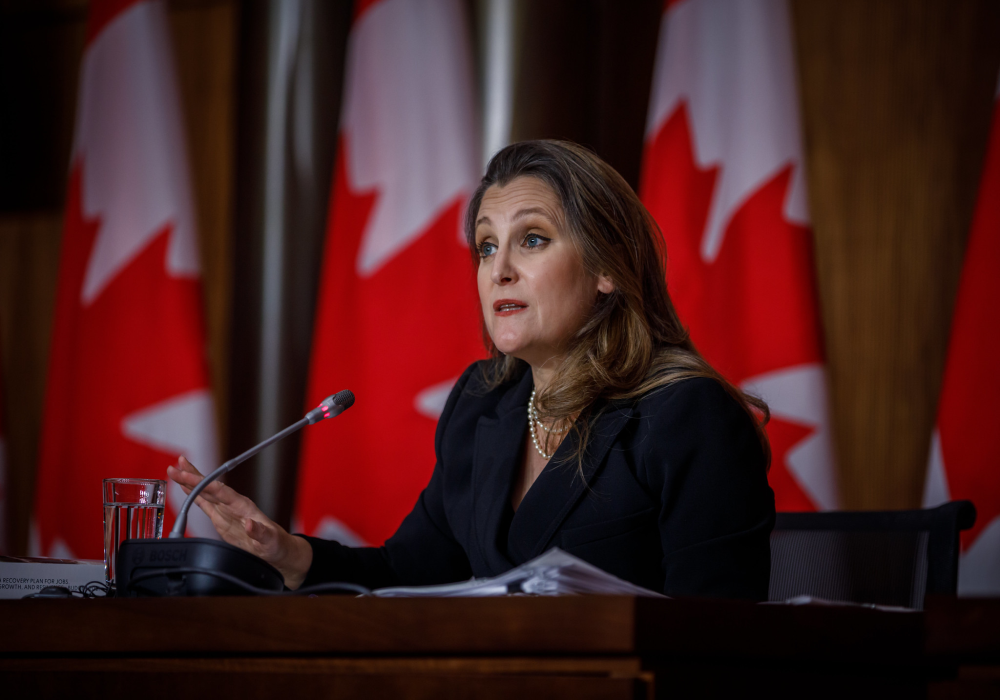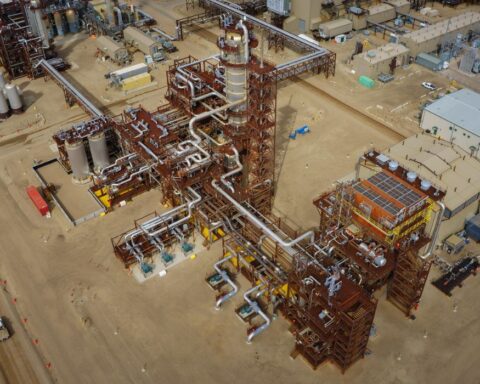An array of new tax credits for clean energy development and a pledge to secure Canada’s place in a global green economy are at the centre of this year’s federal budget, released Tuesday afternoon by Deputy Prime Minister and Finance Minister Chrystia Freeland, with an estimated $80 billion in multi-year funding for mostly clean energy technologies.
In what may be a first for a federal budget in Canada, the document includes an RBC Economics chart that shows electricity from solar and wind costing less than natural gas. “As electricity becomes the main source of energy, daily and seasonal demand peaks will become more pronounced. Canada will need to invest heavily in renewable generation,” the budget says.
The 270-page document lays out eight priorities for the shift to a clean economy: electrification, clean energy, clean manufacturing, emissions reduction, critical minerals, infrastructure, electric vehicles and batteries, and major projects. It introduces three tiers of strategic financing to draw private sector investment to those areas: an “anchor regime” of investment tax credits; low-cost strategic financing through the Canada Infrastructure Bank and the Canada Growth Fund; and targeted investments to meet specific sectoral needs or support projects of “national economic significance.”
Globe and Mail columnist Adam Radwanski says the government’s approach represents a risky bet on private markets that may not deliver financial support equivalent to the Biden administration’s August, 2022 Inflation Reduction Act (IRA). While the U.S. funding directly subsidizes clean energy production, Canada’s investment tax credits focus on the up-front capital cost of getting new production capacity in place, while using the Canada Growth Fund to take some of the risk out of private sector investment.
“If the government has put [the new incentives] in place properly, Canada will be able to compete with the U.S. If not, Ottawa will be forced either to watch cleantech investment head elsewhere or step back into the direct subsidy game from which it is trying to at least partly extricate itself,” Radwanski writes.
“Freeland’s bet is that, with existing Canadian advantages in attracting cleantech investment, such as a national carbon price, Ottawa doesn’t need to fully match what the U.S. is doing on tax credits,” he adds. “But whether it’s come close enough in that regard won’t really be clear until the credits are in place and business decisions are being made accordingly.”
The budget also lays out a series of work force measures, requiring employers that receive federal tax credits to pay prevailing wages based on union rates and set aside at least 10% of tradesperson hours for apprentices. For companies that fall short of those markers, the 15% clean technology and hydrogen tax credits will fall to 5%.
The document mentions future plans to fund biomass energy and introduce carbon contracts for difference, a form of legal agreement that makes the impacts of carbon pricing more predictable and can also protect the budget’s cleantech investments from being overturned by a future government. It also commits Ottawa to disclose the cost of federal subsidies to Volkswagen’s recently-announced battery gigafactory in St. Thomas, Ontario once the deal has been finalized.
“This massive battery manufacturing facility will represent a significant portion of the North American battery manufacturing sector,” the budget document states. “It will cement Canada’s place in the North American and global battery value chains, and create good middle class jobs for Canadians, both at the facility itself and across Canada’s battery and critical minerals sectors.”
The budget mandates the Public Sector Pension Investment Board (PSP Investments) to manage the Canada Growth Fund, while adding two seats for trade union representatives to its board.
It includes funding streams for nuclear power generation through the investment tax credits for clean electricity and cleantech manufacturing.
‘Opportunity of a lifetime’
In her speech to the House of Commons Tuesday afternoon, Freeland framed the 2023 budget as part of “the most significant economic transformation since the Industrial Revolution,” in which Canada’s major trading partners are investing heavily in the clean economy and net-zero industries. At the same time, Russia’s war in Ukraine and the impacts of the pandemic “have cruelly revealed to the world’s democracies the risks of economic reliance on dictatorships,” prompting countries to “friendshore their economies and build their critical supply chains.”
Those two shifts combined “represent the most significant opportunity for Canadian workers in the lifetime of anyone here today,” Freeland said.
But the budget also casts the global shift toward energy transition technologies as a challenge.
After the U.S. IRA poured US$369 billion into mostly clean energy transition technologies, “the sheer scale of U.S. incentives will undermine Canada’s ability to attract the investments” without swift action, the budget document states. “If Canada does not keep pace, we will be left behind. If we are left behind, it will mean less investment in our communities, and fewer jobs for an entire generation of Canadians.”
It adds: “We will not be left behind.”
Gas plants and carbon capture: details to follow
The budget contains no acknowledgement of the $10 billion the fossil fuel industry had demanded to help pay for the carbon capture technologies it sees as its ticket to future oil and gas extraction. In mid-October, the Pathways Alliance, whose six members account for 95% of Canadian oil sands production, announced a $24.1-billion investment in a carbon capture hub in Alberta and a series of other emission reduction projects, but made it conditional on federal support—despite record industry profits, and on top of the $7.1 billion tax credit that Freeland had already sent their way in her 2022 budget.
“Obviously, we would love to see that tax credit explicitly exclude CCUS the oil and gas sector, but I do want to give the government credit where due,” said Vanessa Corkal, senior policy advisor at the Winnipeg-based International Institute for Sustainable Development. With program details still to be announced, “industry will be pushing hard for specific handouts for carbon capture, but I’m happy to see that there aren’t specific measures in this budget.”
The words “oil sands” do not show up in the budget document, but it does apply the clean electricity tax credit to “abated natural gas-fired electricity generation,” opening a door to carbon capture based on an emissions intensity threshold meant to keep any investment in line with the federal government’s 2035 deadline for a net-zero grid. Corkal said carbon capture projects might qualify for finance through the Canada Growth Fund, and Dale Beugin, executive vice president of the Canadian Climate Institute, said carbon contracts for difference could also become a funding pathway for CCUS.
In an analysis posted last week, Beugin said contracts for difference could make it easier for carbon capture projects to generate emission reduction credits that they could sell for cash.
The sliding scale in the hydrogen tax credit could also encourage “blue” hydrogen projects that use CCUS to capture emissions from natural gas, despite expert analysis showing that the technique produces more emissions than just burning the gas. The tax credit ranges from 40% for hydrogen projects that produce less than 750 grams of emissions per kilogram of hydrogen, down to 15% for installations that generate two to four kilos of carbon dioxide or equivalent per kilo of hydrogen.
The hydrogen tax credit continues to shut out projects that would use captured carbon to squeeze more oil out of the ground through a process called enhanced oil recovery (EOR). The fossil fuel lobby had tried and apparently failed to challenge that exclusion in the months leading up to the budget.
Ushering In a ‘New Era’
For climate and energy organizations mostly accustomed to taking their victories in small doses, the budget had a lot to recommend it.
“In terms of impacts for emissions, impacts for clean growth, impacts for competitiveness in a net-zero world, I can’t think of anything that compares to this in a budget,” said Beugin. “It really is a big deal in terms of setting a precedent for a federal game plan for being competitive in net-zero,” even though the “true deficit hawks who are worried about the spending” aren’t likely to be convinced.
In a release, Climate Institute President Rick Smith called Tuesday’s release “the most consequential budget in recent history for accelerating clean growth in Canada” and “a shrewd response to the U.S. Inflation Reduction Act.”
The Canadian Renewable Energy Association said the budget “ushers in a new era for Canadian renewables,” with tax credits that will bolster the industry’s competitiveness. “Canadian investment tax credits will stabilize investment opportunities, while safeguarding affordability for Canadians,” said President and CEO Vittoria Bellissimo. “These new incentives will help create good jobs in clean energy and make Canada a leader in the energy transition.”
“It is mostly a win,” IISD’s Corkal told The Energy Mix. “It’s easy to get bogged down in the flaws, and there are flaws. There are loopholes and things we want to improve. But it’s a win to have this much money identified for clean energy, and now the push will be to make sure those measures are equitable, and that they’re reaching the right projects.”
She added that the budget had little to say in areas like energy efficiency and public transit that received more attention and funding in years past, and left out serious measures to support a just transition to sustainable jobs for fossil fuel work forces. “This is a fairly private sector-focused budget,” she said, but government also “has a role to play in supporting communities to address [climate change] mitigation in their own back yards.”
The Atmospheric Fund CEO Julia Langer said the budget “demonstrates that the government is committing to keeping pace with massive clean energy investment in the U.S. and across the globe,” with an “unprecedented” 13-year allocation to clean electricity. She said it was unfortunate Ottawa had cut the clean electricity tax credit back to a maximum 15% from the 20 to 30% in Freeland’s fall economic statement, but said she was pleased to see the government reinvest in the SREP and smart grid programs and introduce funding for offshore wind.
The Canadian Labour Congress said the budget fell short in extending a helping hand to “hard-pressed” families, but praised measures to create good, sustainable jobs. “The government’s move to attach strings to tax credits to ensure that investments in clean energy create good jobs is positive,” CLC President Bea Bruske said in a statement. “We will continue pressing for unionized, low‑carbon jobs across all sectors of our economy to ensure workers aren’t left behind.”
Still More Ground to Cover
Several other observers of the Canadian climate scene saw gaps in the government’s approach.
“Budget 2023 phases in the good and fails to phase out the bad,” said Climate Action Network-Canada Acting Executive Director Caroline Brouillette.
“Groundbreaking investments in clean electricity will build the grid of the future and provide Canadians with safer, cleaner, and more affordable energy—if underpinned by solid regulations and respect for Indigenous rights and sovereignty,” she added. But the budget “doesn’t show any progress towards fulfilling Canada’s promise to end fossil fuel subsidies this year,” and misses out on just transition/ sustainable job investments that would have reflected “an honest examination of the future of the oil and gas industry in this rapidly shifting global economy.”
“The support given to climate solutions is still a fraction of what is being spent on subsidizing the fossil fuels that are causing the climate emergency,” agreed Julia Levin, associate director, national climate at Environmental Defence Canada. “Carbon capture and hydrogen are great for greenwashing oil and gas, but they won’t deliver meaningful emissions reductions.”
Jamie Kneen, national program co-lead at Mining Watch Canada, warned that mining related to the energy transition “has to be done in the safest way possible. If Canada wants to claim leadership, instead of just shovelling money to mining companies, we need to improve regulation and enforcement.”
Susan O’Donnell, spokesperson for the Coalition for Responsible Energy Development in New Brunswick (CRED-NB), said it was disappointing “to see tax breaks for nuclear fuel reprocessing under the guise of ‘clean tech’. Extracting plutonium from used nuclear fuel has nothing to do with climate mitigation. It is a dirty, dangerous distraction from real climate action.”
Senator Rosa Galvez, who just marked a full year since the introduction of her Climate-Aligned Finance Act, Bill S-243, questioned the government’s decision to put PSP Investments in charge of the Canada Growth Fund, noting that PSP is one of eight Canadian pension funds with direct ties to the fossil fuel industry. That suggests PSP’s new mandate “would do little to avoid inefficient climate solutions that lock in our dependence on fossil fuels,” she said in a release, unless the fund avoids any investments in carbon capture.
Galvez also took issue with the top-up for the government’s CCUS tax subsidy. “Rather than a handout to corporations with record profits, regulation could force the sector to fund their own emissions reductions according to the polluter pays principle,” she said.
Key elements of the $491-billion budget include:
• An 11-year, $25.7-billion investment tax credit for clean electricity that covers 15% of investment costs for more than a dozen power generation, energy storage, and grid transmission technologies—from wind and solar, to natural gas plants with carbon capture if they’re compatible with a 2035 deadline for a net-zero grid;
• A 12-year, $17.7-billion investment tax credit for hydrogen that sets up a sliding scale for different production processes based on their carbon intensity;
• A 12-year, $11.1-billion investment tax credit for clean technology manufacturing that covers 30% of project costs;
• $20 billion in redeployed funding through the Canada Infrastructure Bank for clean power and green infrastructure;
• A commitment to begin investing the $15-billion Canada Growth Fund in the first half of this year;
• $3 billion to renew the government’s Smart Renewables and Electrification Pathways (SREP) and smart grid programs and invest in Canada’s offshore wind potential, particularly off the Nova Scotia and Newfoundland and Labrador coasts;
• $1.5 billion for infrastructure to extract critical minerals to support battery and electric vehicle manufacturing;
• $1.4 billion over 12 years in income tax reductions for zero-emission technology manufacturers;
• A $520-million top-up to the existing $7.1-billion tax credit for carbon capture, utilization and storage (CCUS), with provisions that extend the program to new types of equipment and to geological storage in British Columbia;
• $40.4 million over five years to establish a NATO climate centre in Montreal;
• $34.1 million over three years to help eastern Canadian farmers reduce their need for nitrogen fertilizers.
This article is republished from The Energy Mix. Read the original article.







